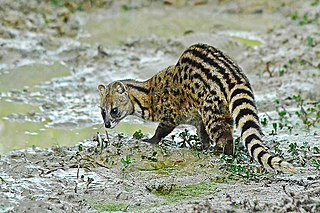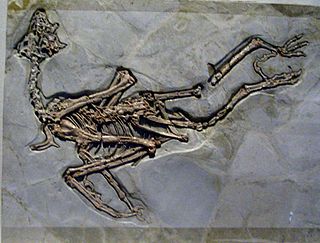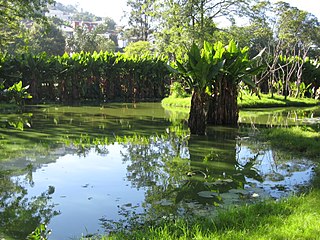
Elephant birds are members of the extinct ratite family Aepyornithidae, made up of flightless birds that once lived on the island of Madagascar. They are thought to have become extinct around 1000-1200 CE, probably as a result of human activity. Elephant birds comprised the genera Mullerornis, Vorombe and Aepyornis. While they were in close geographical proximity to the ostrich, their closest living relatives are kiwi, suggesting that ratites did not diversify by vicariance during the breakup of Gondwana but instead evolved from ancestors that dispersed more recently by flying.

Nepenthes madagascariensis is one of two Nepenthes pitcher plant species native to Madagascar, the other being N. masoalensis.

The small Indian civet is a civet native to South and Southeast Asia. It is listed as Least Concern on the IUCN Red List because of its widespread distribution, widespread habitat use and healthy populations living in agricultural and secondary landscapes of many range states.
Nepenthes masoalensis is one of two tropical pitcher plant species from Madagascar, the other being N. madagascariensis.

Gallieniellidae is a family of spiders first described by J. Millot in 1947. It was originally thought to be endemic to Madagascar until species were also found in southern Kenya, northeastern Argentina, and Australia. Drassodella was transferred from the family Gnaphosidae in 1990. They are suspected to be specialized in ant-preying.

Phyxelididae is a family of araneomorph spiders first described by Pekka T. Lehtinen in 1967 as a subfamily of Amaurobiidae, and later elevated to family status as a sister group of Titanoecidae.
Synaphridae is a family of spiders with thirteen described species in three genera. It was first described as a subfamily of Anapidae, but it has since been raised to family status.

Cyatholipidae is a family of spiders first described by Eugène Simon in 1894. Most live in moist montane forest, though several species, including Scharffia rossi, live in dry savannah regions. They occur in Africa, including Madagascar, New Zealand and Australia, and one species in Jamaica. Most members of this family hang beneath sheet webs. Fossil species occur in the Eocene aged Bitterfield and Baltic Ambers, suggesting a wider geographic distribution in the past.

Cetiosauridae is a family of sauropod dinosaurs which was first proposed by Richard Lydekker in 1888. While traditionally a wastebasket taxon containing various unrelated species, some recent studies have found that it may represent a natural clade. Alongside Cetiosaurus from the Middle Jurassic of Britain, other taxa recently assigned to the family include Lapparentosaurus from the Middle Jurassic of Madagascar, and Patagosaurus from the late Early-Middle Jurassic of Patagonia, which share autapomorphies with Cetiosaurus that are not shared by other eusauropods. Additionally, at least one study has suggested that the mamenchisaurids may represent a sub-group of the cetiosaurids, which would be termed Mamenchisaurinae.

Ambatolampy is a city in the Vakinankaratra Region, situated in the Central Highlands of Madagascar. It had a population of about 28,500 in 2013.
The University of Toamasina is a public university in Toamasina, Madagascar. The university campus is located in Barikadimy west of the city of Toamasina, the capital of Atsinanana on the east side of Madagascar.

Omnivoropterygidae is a family of primitive avialans known exclusively from the Jiufotang Formation of China, though putative omnivoropterygids are known from the Maevarano Formation of the Maastrichtian of Madagascar. They had short skeletal tails and unusual skulls with teeth in the upper, but not lower, jaws. Their unique dentition has led some scientists to suggest an omnivorous diet for them. The family was named by Stephen A. Czerkas & Qiang Ji in 2002, though its junior synonym Sapeornithidae is often used instead, though it was named four years later in 2006. It is the only named family in the order Omnivoropterygiformes.

Voay is an extinct genus of crocodile from Madagascar that lived during the Late Pleistocene to Holocene, containing only one species, V. robustus. Numerous subfossils have been found, including complete skulls, noted for their distinctive pair of horns on the posterior, as well as vertebrae and osteoderms from such places as Ambolisatra and Antsirabe. The genus is thought to have become extinct relatively recently. It has been suggested to have disappeared in the extinction event that wiped out much of the endemic megafauna on Madagascar, such as the elephant bird and Malagasy hippo, following the arrival of humans to Madagascar around 2000 years ago. Its name comes from the Malagasy word for crocodile.

The Central Highlands, Central High Plateau, or Hauts-Plateaux are a mountainous biogeographical region in central Madagascar. They include the contiguous part of the island's interior above 800 m (2,600 ft) altitude. The Central Highlands are separated from the Northern Highlands of the northern tip of Madagascar by a low-lying valley, the Mandritsara Window, which has apparently acted as a barrier to dispersal for species in the highlands, leading to species pairs such as Voalavo gymnocaudus and Voalavo antsahabensis in the Northern and Central Highlands. Species restricted to the Central Highlands include the bats Miniopterus manavi and Miniopterus sororculus; the rodents Brachyuromys betsileoensis and Voalavo antsahabensis; the tenrecs Hemicentetes nigriceps and Oryzorictes tetradactylus; and the lemur Cheirogaleus sibreei. Because of the continuous habitat of the Central Highlands, there is little local endemism, unlike the Northern Highlands.

The Botanical and Zoological Garden of Tsimbazaza, short Tsimbazaza Zoo is a zoological and botanical garden in the neighbourhood of Tsimbazaza in Antananarivo, Madagascar, located just north of the National Assembly of Madagascar building.
Alexey Nikolaievich Diakonoff, also transliterated as Alexej Nikolajewitsch Diakonoff, was a Russian–Dutch entomologist who specialised in Microlepidoptera.
Sarimanok is a vinta that was sailed in 1985 from Bali to Madagascar across the Indian Ocean to replicate ancient seafaring techniques. The ship is now at the Oceanographic Museum of Nosy Be, an island off the northeastern coast of Madagascar.

Udubidae is a family of araneomorph spiders, most of whose members were formerly placed in the family Zorocratidae, which is no longer accepted.
This page lists all described species of the spider family Viridasiidae accepted by the World Spider Catalog as of December 2020:

University of Antananarivo is the primary public university of Madagascar, located in the capital Antananarivo.














